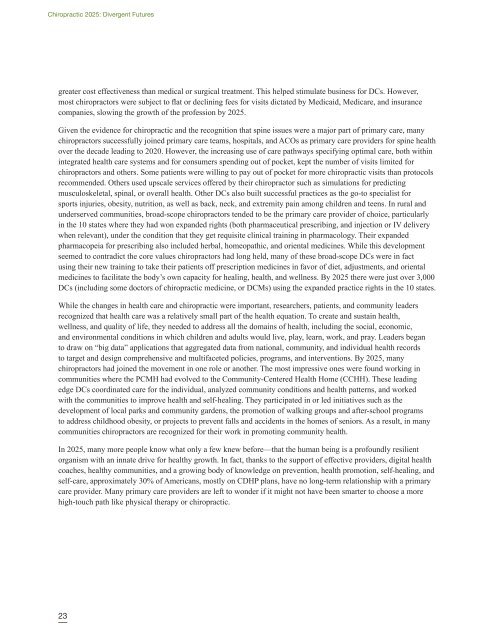Chiropractic 2025:
Chiropractic 2025:
Chiropractic 2025:
You also want an ePaper? Increase the reach of your titles
YUMPU automatically turns print PDFs into web optimized ePapers that Google loves.
<strong>Chiropractic</strong> <strong>2025</strong>: Divergent Futures<br />
greater cost effectiveness than medical or surgical treatment. This helped stimulate business for DCs. However,<br />
most chiropractors were subject to flat or declining fees for visits dictated by Medicaid, Medicare, and insurance<br />
companies, slowing the growth of the profession by <strong>2025</strong>.<br />
Given the evidence for chiropractic and the recognition that spine issues were a major part of primary care, many<br />
chiropractors successfully joined primary care teams, hospitals, and ACOs as primary care providers for spine health<br />
over the decade leading to 2020. However, the increasing use of care pathways specifying optimal care, both within<br />
integrated health care systems and for consumers spending out of pocket, kept the number of visits limited for<br />
chiropractors and others. Some patients were willing to pay out of pocket for more chiropractic visits than protocols<br />
recommended. Others used upscale services offered by their chiropractor such as simulations for predicting<br />
musculoskeletal, spinal, or overall health. Other DCs also built successful practices as the go-to specialist for<br />
sports injuries, obesity, nutrition, as well as back, neck, and extremity pain among children and teens. In rural and<br />
underserved communities, broad-scope chiropractors tended to be the primary care provider of choice, particularly<br />
in the 10 states where they had won expanded rights (both pharmaceutical prescribing, and injection or IV delivery<br />
when relevant), under the condition that they get requisite clinical training in pharmacology. Their expanded<br />
pharmacopeia for prescribing also included herbal, homeopathic, and oriental medicines. While this development<br />
seemed to contradict the core values chiropractors had long held, many of these broad-scope DCs were in fact<br />
using their new training to take their patients off prescription medicines in favor of diet, adjustments, and oriental<br />
medicines to facilitate the body’s own capacity for healing, health, and wellness. By <strong>2025</strong> there were just over 3,000<br />
DCs (including some doctors of chiropractic medicine, or DCMs) using the expanded practice rights in the 10 states.<br />
While the changes in health care and chiropractic were important, researchers, patients, and community leaders<br />
recognized that health care was a relatively small part of the health equation. To create and sustain health,<br />
wellness, and quality of life, they needed to address all the domains of health, including the social, economic,<br />
and environmental conditions in which children and adults would live, play, learn, work, and pray. Leaders began<br />
to draw on “big data” applications that aggregated data from national, community, and individual health records<br />
to target and design comprehensive and multifaceted policies, programs, and interventions. By <strong>2025</strong>, many<br />
chiropractors had joined the movement in one role or another. The most impressive ones were found working in<br />
communities where the PCMH had evolved to the Community-Centered Health Home (CCHH). These leading<br />
edge DCs coordinated care for the individual, analyzed community conditions and health patterns, and worked<br />
with the communities to improve health and self-healing. They participated in or led initiatives such as the<br />
development of local parks and community gardens, the promotion of walking groups and after-school programs<br />
to address childhood obesity, or projects to prevent falls and accidents in the homes of seniors. As a result, in many<br />
communities chiropractors are recognized for their work in promoting community health.<br />
In <strong>2025</strong>, many more people know what only a few knew before—that the human being is a profoundly resilient<br />
organism with an innate drive for healthy growth. In fact, thanks to the support of effective providers, digital health<br />
coaches, healthy communities, and a growing body of knowledge on prevention, health promotion, self-healing, and<br />
self-care, approximately 30% of Americans, mostly on CDHP plans, have no long-term relationship with a primary<br />
care provider. Many primary care providers are left to wonder if it might not have been smarter to choose a more<br />
high-touch path like physical therapy or chiropractic.<br />
23


